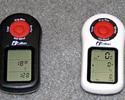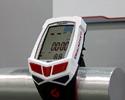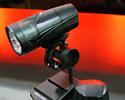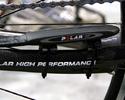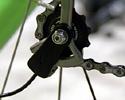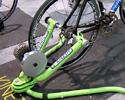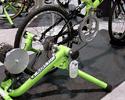
Recently on Cyclingnews.com |
Interbike Show
Las Vegas, Nevada, USA, September 24 - 28, 2007
Main Page Previous Part Next Part
Part 8: Cool electronic gadgetry from Vegas
By James Huang
Velocomp improves accuracy and adds key functionality to iBike Pro
|
|
|
We dubbed the iBike Pro power meter 'Best Electronic Widget' of last year's Interbike show, and this year's improvements only serve to reassure us that we made the right call. For 2008, Velocomp has added a wireless version of its iBike Pro and a heap of features across the board, all while cleverly making no physical changes to the head unit itself. The ANT+Sport-compatible wireless protocol also means the iBike can 'talk' to other so-equipped pieces of hardware, such as Garmin's new Edge 705.
The new wireless model now features a rear wheel speed pickup and integrated cadence sensor, as well as full heart rate monitor functionality. The new sensor location means that speed will now finally be displayed during indoor training sessions, but a new software feature will now also register virtual power output, too, as long as riders use one of the 'popular indoor trainers' that Velocomp has calibrated in its lab.
The updated software now includes an automatic correction feature, which can supposedly rectify any anomalies in the iBike unit's built-in accelerometer and also retroactively fix a bad calibration, and can now calculate the amount of braking time (and the associated scrubbed energy) in any given workout. Other software upgrades improve how the data is displayed and analyzed, and new firmware increases the head unit's battery life. Last, but certainly not least, a new calibration procedure can now more easily correct for tilt and wind anomalies and will also supposedly calculate coefficients of aerodynamic drag and rolling resistance.
The best news, by far, though, is that all of these new features can be fully retrofitted to existing iBike Pro units. The only required upgrades are the new wireless receiver-equipped mount, which will now be available in both stem- and bar-mounted options, and a firmware update. The upgrade kit (including iBike mount, HRM strap, and speed/cadence sensor) will run existing iBike owners US$269, while new wireless units will command US$698, still a rather amazingly reasonable figure considering the feature set.
Blackburn goes wireless with Neuro
|
|
|
Blackburn's Delphi line of bicycle computers received a warm welcome for its exceptional ease of use, packed feature set, tidy styling, and reasonable cost. For 2008, Blackburn moves a bit further upscale with the new Neuro line, which builds on the Delphi by adding 2.4GHz wireless transmission across the range.
Naturally, the Neuro's ANT+Sport compatible signal is digitally encoded to prevent interference, and the new speed and cadence transmitters are cleanly integrated into a single unit that mounts on the non-driveside chain stay. A single head can be swapped between two sets of sensors, a feature which by itself is nothing new or spectacular, but the Neuro automatically detects which set of transmitters it is paired to and then adjusts the built-in setting (such as wheel size) accordingly. Now that's cool.
In addition to the new wireless transmission, the Neuro line also caters more specifically to the serious trainer with a five-zone heart rate monitor (Delphi models are three-zone) and a unique 'Race Mode' that displays only critical information.
Sunlight-sapping Daylight Savings is nearly over, and Blackburn has revamped its LED-based System X line of lights just in time. The biggest improvement, by far, is the new Li-ion battery which replaces last year's NiMH unit. The change in chemistry yields a pack which is just one-third the size of the original, and the new smoother shape is also easier to mount on the bike or toss into a jersey pocket. Blackburn carries over the 3W Luxeon emitters and still houses them in versatile handlebar- or helmet-mounted heads, and still utilizes the very-useful advanced Constant Current and SuperCharger technology.
New Polar CS600 computer is a coach's dream come true
|
|
|
Polar's new CS400 and CS600 offer integrated solutions that combine a fully-functioned cycle computer with sophisticated HRM features. Both utilize a large-format LCD display and wireless speed and cadence sensors, along with Polar's usual panoply of training aids, including three target heart rate zones and its handy OwnZone and OwnCal features.
The top-end CS600 is also compatible with Polar's new WIND power meter, which, like its older units, calculates power output based on the speed and tension of your chain (huh? We haven't sampled it ourselves yet, but supposedly it actually works pretty well) while still allowing you to run your usual componentry. In addition, the WIND unit is now a 2.4GHz wireless widget and is far easier to install than older Polar setups.
Those features easily put Polar's new computers among the top offerings these days, but the real draw is the new software. Users can preprogram specific planned workouts on their home computer, each containing up to five intervals with varied recovery periods and repeats for each one. These workouts can then be saved in a 'personal library' that can be planned up to three weeks ahead.
The truly amazing part is that these structured efforts can then be uploaded to the CS600 unit itself, which subsequently prompts you as to what you should be doing in terms of heart rate and/or power output. Since the workouts are preprogrammed in advance and have specific dates associated with them, the CS600 even tells you what workout is planned for the day when you wake up in the morning. Workouts can be provided remotely by an athlete's coach, and the software is compatible with the ubiquitous TrainingPeaks/CyclingPeaks software for later analysis. Save for having your coach follow you around in a car with a bullhorn (or get you out of bed), this is likely the next best thing to the hands-on treatment.
Kurt Kinetic
|
|
|
Fall has already arrived for those of us in the northern hemisphere, and winter isn't much further off. For the unfortunate majority, that also means that cycling will be mostly restricted to indoor use until the mercury rises to a more reasonable level. Kurt Kinetic offers up some assistance by providing its own brand of, er, resistance!
The Rock&Roll uses a wide base with a uniquely pivoting cradle that allows bikes to sway side-to-side to more closely mimic real-world conditions while also helping users refine their technique. A dual flywheel system offers 6, 12, or 18lb (2.7, 5.4, or 8.2kg) of rotational weight also delivers more realistic acceleration and coast-down feel. An optional Turn-Table front wheel support also allows the front wheel to 'steer' to further help users polish up on their balance and stability.
All of Kurt Kinetic's fluid resistance units use the company's patented magnetically coupled impeller system in which there is no shaft physically entering the fluid chamber. As there are no dynamic seals involved, the chance of leakage is virtually eliminated. Kurt Kinetic also uses a relatively thermodynamically neutral silicone-based fluid instead of more common oils in order to maintain a more consistent resistance profile as temperatures increase inside the finned housing.
Kurt Kinetic also includes its fluid resistance unit on the more conventional Pro Trainer and Road Machine trainers, while wind resistance is used for the more inexpensive Cyclone. All three are built with a stable, height-adjustable, wide-set frame that can supposedly accommodate wheel sizes ranging from 16" all the up to 29" (outside diameter).
Photography
For a thumbnail gallery of these images, click here
Images by James Huang/Cyclingnews.com
- The surprisingly effective iBike Pro is now available in black and white.
- A new wireless option integrates cadence and heart rate monitor functionality, and is also retrofittable to older iBike models.
- New software combines with the wireless rear wheel pickup to supposedly yield accurate power readings for most popular indoor trainers.
- The best part of the new iBike improvements is that they are fully adaptable to first generation models, meaning early adopters aren't left out in the cold.
- Polar's new CS400 and CS600 computers offer some handy training features for cyclists.
- The WIND power meter sensor is a bit cleaner than first generation versions.
- The WIND calculates power by measuring the tension in the chain…
- …relative to how fast it's moving.
- A small battery case is mounted to the seat stay and uses easily available cells for replacement.
- Perhaps the biggest innovation of Polar's power meter lineup is its new software package, which offers users a long-term overview of their training schedule.
- Even better, though, is that users can preprogram specific workouts into the software, which then uploads the information to the on-bike computer.
- Kurt Kinetic continues to offer its fluid trainers for 2008.
- The adjustable frame can accommodate a wide range of wheel sizes, including smaller 20" models.
- The new Rock&Roll trainer uses a pivoting base to better simulate real riding conditions.
- Kurt Kinetic's 'Turn-Table Ring' front wheel stand pivots for even more realism, forcing users to keep the front end stable instead of relying on a fixed crutch.
- A curious Interbike attendee gives Kurt Kinetic's Rock&Roll a spin.
- The heart of Kurt Kinetic's fluid trainers is a magnetically-coupled impeller that has absolutely no dynamic seals, making it nearly completely impervious to leaking.
- Blackburn built on the success of its Delphi computer line to create the new Neuro.
- The Neuro line uses digitally-encoded 2.4GHz wireless transmission and more advanced training features.
- A tidy sensor incorporates both speed and cadence , and an optional stem mount kit is also available.
- Last year's System X3 and X6 lights have been revamped to create the far smaller and tidier X4 and X8 systems.
- The handy Voyager 4.0 is now offered in a rechargeable version.
- Ergomo expands its range of carbon cranksets for 2008.
- The new cranks were developed in conjunction with Stronglight and include the handy ALS adjustable crank length system.
- The new Ergomo MTB crankset incorporates a stainless steel guard.
- Ergomo's newest computer mounts integrate the head far more cleanly than first generation models.
- The Ergomo setup is unique in that it uses an optical sensor instead of a strain gage.
- Elite's new Realpower CT trainer is supposedly the "first and only home trainer that can replicate faithfully slopes up to 20%". 20%? Ouch.
- An electromagnetic resistance unit is controlled by the attached computer.

